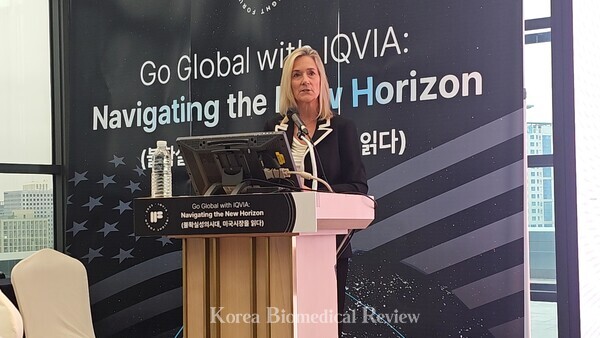IQVIA highlighted how sweeping structural changes at key U.S. health agencies under the second Trump administration are reshaping the regulatory and policy environment for drug development, calling attention to emerging challenges and opportunities driven by artificial intelligence (AI), real-world data, and agency workforce reductions.

Speaking at the IQVIA Insight Forum 2025, Cynthia Verst, President of Design and Delivery Innovation, R&D Solutions at IQVIA, said the U.S. has entered a phase of policy changes that will require pharmaceutical companies and clinical research organizations to review development strategies.
“We are in a time of great uncertainty in the U.S., and it’s critical to understand the evolving environment,” Verst said, noting that IQVIA actively monitors legislative and executive branch developments through its presence on Capitol Hill and advisory roles in industry organizations such as the Association of Clinical Research Organizations and Drug Information Association.
Among the most consequential updates was President Donald Trump’s recent executive order mandating reduced reimbursement rates for drugs under Medicare and Medicaid, a move widely seen as a signal of broader pricing reforms ahead.
However, Verst emphasized that pricing was only part of a broader transformation, led by structural overhauls at the Department of Health and Human Services (HHS) and the U.S. FDA.
Citing early policy directions under HHS Secretary Robert F. Kennedy Jr. and newly appointed FDA Commissioner Martin McCary, Verst said U.S. regulators appear poised to shift away from rigid clinical trial frameworks toward expanded use of real-world evidence and potentially looser standards around the requirement for adequate and well-controlled trials.
“There’s a vision emerging for transforming clinical development, one that encourages leans on long-term patient tracking and incorporates real-world data drawn from outside traditional trials,” she explained.
The Trump administration is also advancing a more relaxed posture toward mergers and acquisitions, according to Verst, particularly through changes at the Federal Trade Commission (FTC).
Verst stressed this is seen as a potential tailwind for portfolio diversification, especially as biopharma companies navigate new patent exclusivity rules under the Inflation Reduction Act (IRA), which imposes different restrictions depending on whether the therapy is a small molecule or a large/biologic molecule.
Another focal point of the session was AI.
Verst noted that while past FDA guidance on AI centered on risk management and safety, regulators are now mandating the adoption of generative AI tools for internal use, particularly for medical reviewers conducting literature analysis.
“This isn’t just about AI oversight anymore,” Verst said. “It’s about operational transformation inside the FDA itself.”
IQVIA, one of the global leaders in health data analytics and clinical research services, has compiled these intersecting themes into a proprietary quadrant model that maps regulatory trends by their likelihood of implementation and potential industry impact.
High-impact and high-probability developments, such as AI integration and agency restructuring, were color-coded as regulatory tailwinds, while areas such as staffing shortages and procedural bottlenecks were flagged as red headwinds.
One of the most pressing concerns, Verst said, is the reduction of full-time federal regulatory staff.
HHS has already lost an estimated 20,000 positions, despite overseeing $1.8 trillion in federal healthcare spending, while the FDA cut approximately 3,500 jobs, around 19 percent of its workforce.
“The commissioner himself admitted that despite doubling staffing since 2007, drug approvals and review timelines haven’t improved,” Verst said, referencing congressional testimony from Commissioner McCary.
While McCary has pledged that core roles such as medical reviewers and inspectors will remain untouched, Verst warned that attrition is already being felt.
“We’re seeing those very people leave,” she said. “That raises serious concerns about continuity, especially in safety-critical areas.”
A leaked version of the 2026 federal budget added to the uncertainty, outlining proposed budget cuts to the FDA, NIH, and CDC, and a reorganization plan that would collapse more than 20 FDA centers into five.
Although McCary has since denied that any such reorganization will proceed, Verst said the mere appearance of instability is unsettling stakeholders across the biopharma ecosystem.
She also recalled the legacy of the Prescription Drug User Fee Act (PDUFA), passed in the 1990s to accelerate drug approvals and stabilize the FDA through industry-funded timelines.
“Even today, industry fees still fund a major share of FDA operations, and protecting those timelines remains a non-negotiable priority,” she noted.
Still, signs of slowdown are emerging.
Verst pointed to reports from biotechnology companies experiencing longer waits for pre-IND and INTERACT (INitial Targeted Engagement for Regulatory Advice on CBER/CDER ProducTs) meetings, which is a meeting at a specific time early in product development.
She added that the agency is increasingly relying on written feedback instead of live discussions, potentially impairing early-phase planning.
Despite these growing pains, Verst stressed that innovation remains alive especially for indications that have a high unmet need.
“New pathways are being considered for ultra-rare diseases, including single-trial approvals and reliance on post-marketing safety data,” she said. “There’s also talk of eliminating animal testing requirements for biologics such as monoclonal antibodies.”
Ultimately, Verst argued, the industry should view the present turbulence not as a crisis but as a pivot point.
“There will be short-term pain, but the long-term outlook is one of opportunity, if we adapt, particularly in AI, evidence generation, and regulatory strategy,” she concluded.
Related articles
- Celltrion chief backs Trump’s PBM crackdown as ‘biosimilar boost,’ but halves Zymfentra forecast
- Huons expects limited impact from Trump drug pricing order on anesthetic exports
- Celltrion looks to gain as Trump pushes for lower drug prices
- [BIO KOREA 2025] With tariffs looming, Celltrion backs biologics push with US stockpile
- KoreaBIO urges US to exempt Korean pharmaceuticals from potential tariffs
- Korean drugmakers scramble for clarity as US weighs drug tariffs amid price-cut push
- Tariff fears wipe out $24 bil. from Korean drugmakers, sink biopharma stocks

